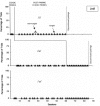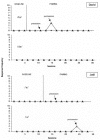Evaluating stimulus-stimulus pairing and direct reinforcement in the establishment of an echoic repertoire of children diagnosed with autism
- PMID: 22477313
- PMCID: PMC2774102
- DOI: 10.1007/BF03393009
Evaluating stimulus-stimulus pairing and direct reinforcement in the establishment of an echoic repertoire of children diagnosed with autism
Abstract
Many children with autism do not imitate adult vocalizations, an important skill in learning to talk. Pairing adult vocalizations with preferred stimuli has been shown to increase free-operant vocalizations but effects are temporary; thus, direct reinforcement may be necessary to establish durable vocal behaviors. In Experiment 1, directly reinforced echoic responses did not increase following stimulus-stimulus pairings in three children with autism. Similarly, pairings did not increase free-operant vocalizations in Experiment 2, a replication of Miguel et al. (2002). Experiment 3 demonstrated that shaping increased vowel frequency for one participant. Results suggest that variables are yet to be delineated that influence effectiveness of a stimulus-stimulus pairing procedure on vocalization frequency and acquisition of a verbal operant following such pairings.
Figures





References
-
- Bijou S. W, Baer D. M. Child development: Vol. 2. Universal stage of infancy. New York: Appleton-Century-Crofts; 1965.
-
- Brown R. A first language: The early stages. Cambridge, MA: Harvard University Press; 1973.
-
- Bzoch K. R, League R, Brown V. L. Receptive-expressive emergent language test. (3rd ed.) Austin, TX: Pro-Ed; 2003.
-
- Chomsky N. A review of B. F. Skinner's Verbal Behavior. Language. 1959;35:26–58.
LinkOut - more resources
Full Text Sources

